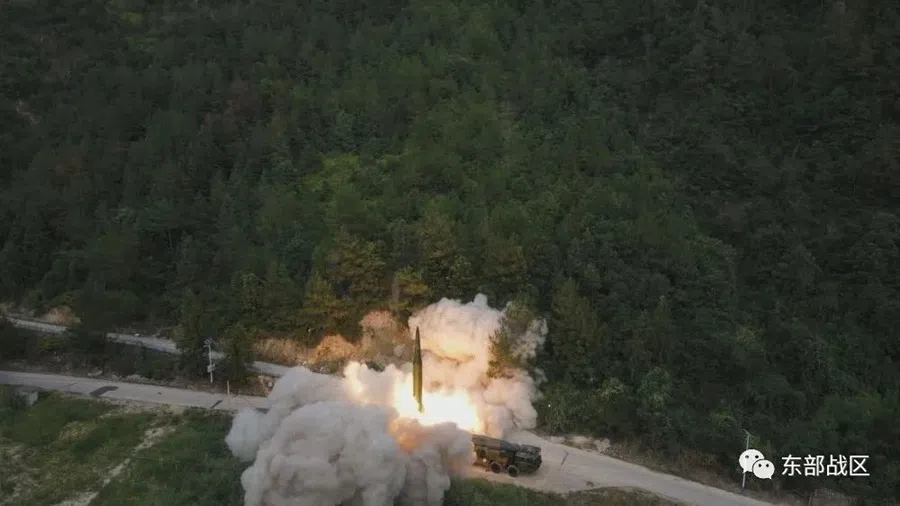China may turn Japan row into a strategic ‘new normal’
Comments by Japanese Prime Minister Sanae Takaichi on Taiwan have sparked a backlash in China. Lianhe Zaobao correspondent Sim Tze Wei notes that Beijing could use the dispute to normalise its military and diplomatic posture while revealing strategic plans long prepared for regional contingencies.

China-Japan relations have taken a sharp turn for the worse over the Taiwan issue, calling to mind two earlier moments when tensions in Northeast Asia flared dramatically.
In 2012, Japan nationalised the Diaoyu Islands (known in Japan as the Senkaku Islands), triggering anti-Japanese protests across multiple Chinese cities. In 2022, then US House Speaker Nancy Pelosi visited Taiwan, prompting Beijing to launch large-scale military exercises “encircling” the island.
And now in 2025, Japanese Prime Minister Sanae Takaichi told the Diet that a contingency in Taiwan would constitute a “survival-threatening situation” for Japan, allowing it to exercise the right of collective self-defence — a remark that drew a “decapitation” rebuttal from Xue Jian, China’s consul general in Osaka. Across these three incidents at three different points in time, much has changed, and much has stayed the same.
A shift in mode of protests
The most striking difference, at least on the surface, is that China’s mode of protest has shifted from large-scale street demonstrations to online eruptions, with the shift occurring around the time of the Chinese Communist Party’s (CCP) 18th Party Congress in November 2012. Before the congress, in August and September 2012, anti-Japanese demonstrations erupted across many parts of China, drawing massive crowds to the streets.
Back then, journalists including myself walked among the crowds of protesters, pacing back and forth in front of the embassy of Japan in Beijing. Some demonstrators even held up portraits of Mao Zedong, which left a deep impression.
In both the 2012 and 2022 crises, China made full use of the moment, establishing “new normals” that worked to its advantage.

This time, there have been no anti-Japanese street protests in China. Instead, criticisms of Takaichi and the Japanese government bombarded mobile phones, the internet and television.
“Never let a good crisis go to waste,” Winston Churchill supposedly quipped. In both the 2012 and 2022 crises, China made full use of the moment, establishing “new normals” that worked to its advantage.
The Diaoyu Islands remain under Japan’s de facto control, and for a long time, there has been no major clash as both sides have exercised restraint. However, after the 2012 incident, China began sending government vessels and coast guard ships into the contiguous zone around the islands with increasing frequency. These “rights enforcement patrols” have since become routine, aimed at asserting its sovereignty.
Actions by China
Quoting the Japan Coast Guard, Kyodo News reported on 21 October that since the nationalisation of the Diaoyu Islands in September 2012, Chinese government vessels have sailed continuously in the surrounding waters for as many as 335 days — with the ships believed to have withdrawn only to avoid unfavourable weather.
Similarly, after Pelosi’s visit to Taiwan in August 2022, the mainland’s People’s Liberation Army (PLA) immediately launched large-scale drills encircling Taiwan and proceeded to normalise its military presence. Taiwanese media reported that the PLA has made frequent incursions into the airspace around the Taiwan Strait, at times crossing the median line, in an attempt to make grey zone interference routine.
This latest diplomatic row triggered by Takaichi’s remarks may also offer Beijing an opportunity to establish yet another “new normal”.

This latest diplomatic row triggered by Takaichi’s remarks may also offer Beijing an opportunity to establish yet another “new normal”. For example, in response to Japan stepping up its military surveillance, China could increase the frequency of naval deployments through the strait between Yonaguni Island and Taiwan to expand its military presence.
More broadly, the greatest opportunity Beijing may seize from this episode is to pressure Takaichi into retracting her claim that “a Taiwan contingency is a Japan contingency”, thereby constraining Japan’s scope to exercise collective self-defence and weakening the military deterrence that the US-Japan alliance poses to Beijing in the Taiwan Strait.
Possible scenarios
As Professor Heng Yee-Kuang from the University of Tokyo’s Graduate School of Public Policy analysed: “If Takaichi’s intention (by her remarks) is to prevent Beijing from attacking Taiwan, then Beijing is presently trying to prevent Japan from intervening”. This is precisely one of the reasons why Beijing continues to exert pressure on Takaichi.
According to the Taiwan Strait wargame report published in 2023 by the Washington-based think tank Center for Strategic and International Studies (CSIS), four conditions must be met to successfully repel the PLA in the event that Beijing attacks Taiwan.
First, Taiwanese forces must hold the line. Second, in peacetime, the US and Taiwan must work together to provide Taiwan with the weapons it needs; in wartime, if the US decides to defend Taiwan, US forces must quickly engage in direct combat. Third, the US must be able to use its bases in Japan for combat operations. Fourth, the US must be able to strike the Chinese fleet rapidly and en masse from outside the Chinese defensive zone.
... of the 24 scenarios depicted in the CSIS war game, Beijing fails in 23, with only one scenario allowing Beijing to capture Taiwan — if Japan refuses to allow the US to use its military bases within Japan. — Masashi Murano, Author, Preventing a US-China War

Japanese academic Masashi Murano, in his new book Preventing a US-China War published this year, stated that of the 24 scenarios depicted in the CSIS war game, Beijing fails in 23, with only one scenario allowing Beijing to capture Taiwan — if Japan refuses to allow the US to use its military bases within Japan. This is because if the US military is forced to fly from Guam, their operational efficiency would significantly decrease. In other words, Japan can play a crucial role in the Taiwan Strait crisis due to its key geostrategic position.
The “survival-threatening situation” is a new provision added to Japan’s security legislation passed in 2015. According to Kyodo News, this refers to a situation where “armed attack against a foreign country that is in a close relationship with Japan occurs and as a result threatens Japan’s survival and poses a clear danger to fundamentally overturn people’s right to life, liberty and pursuit of happiness”. This is one of the conditions under which Japan’s Self-Defense Forces can exercise limited collective self-defence rights.
US and Japan putting on an act?
Much public opinion in mainland China believes that “a foreign country that is in a close relationship with Japan” refers to Taiwan, and Takaichi’s remarks have been harshly criticised for implicitly regarding Taiwan as a country. However, many Japanese and Taiwanese media reports suggested instead that it refers to the US. Moreover, whether Japan exercises collective self-defence rights is to a large extent influenced by the US.
Interestingly, while China and Japan remain at an impasse, Washington has yet to issue a clear statement, which could perhaps be interpreted as a stance of strategic ambiguity. Nonetheless, US ambassador to Japan George Glass has voiced support for Japan on the X platform, while US chief of naval operations Admiral Daryl Caudle told Japanese media during his visit to Japan that he understood Takaichi’s position, adding that “I can’t say I’m surprised”. This has led some mainland Chinese commentators to believe that the US and Japan are putting on a coordinated act.
The China-Japan relationship, which went through a two-year freeze more than a decade ago due to the Diaoyu Islands dispute, officially thawed only after that period. Today, it may similarly fail to improve in the short term. Moreover, the current dispute could unexpectedly reveal some strategic plans prepared for a Taiwan Strait contingency, as a tug of war continues between Beijing, which seeks to prevent Japanese involvement, and the US-Japan alliance, which aims to maintain deterrence.
This article was first published in Lianhe Zaobao as ““台湾有事”预演亮底牌?”.





